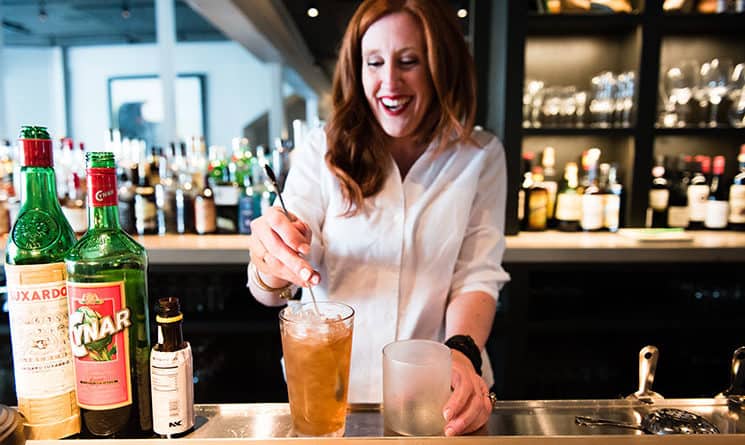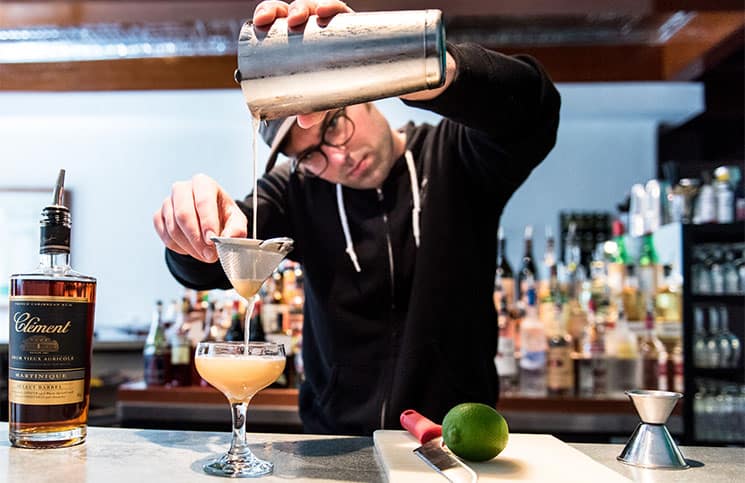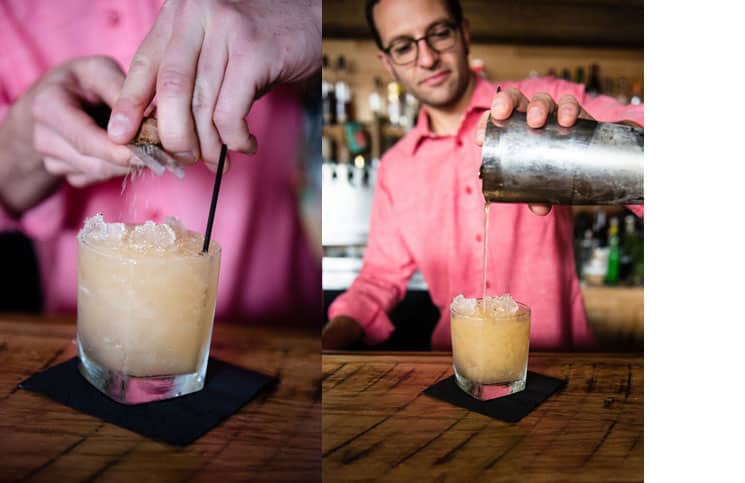There’s never been a lack of places to get a good cocktail on the Seacoast. Establishments like The Library Restaurant in Portsmouth, The Carriage House in Rye, and Orchard Street Chop Shop in Dover have long served classic cocktails to complement perfectly cooked plates of red meat and local seafood. A decade or two ago, the old fashioned, Gibson, and sidecar were among the more common cocktails, but the people who ordered them usually had a full head of gray hair.
A look at the cocktail menus at Seacoast-area restaurants today reveals how much things have changed in cocktail culture here, and how much references the past. Bartenders continue to push the limits, regardless of whether there are oysters on the menu or burgers. Unusual liquors, house-made ingredients, and multiple layers of flavor are bringing fresh life to the cocktail, but local establishments are doing so with a heavy nod to those old-school bar classics.
At Louie’s in Portsmouth, the most popular cocktail on the menu is the Inside Job, made with bourbon, Luxardo Maraschino liqueur, and Cynar. It’s “a Manhattan dressed up,” said Louie’s bar manager Megan McNeil. The Cynar is part of Louie’s wide selection of Amari, a style of bitter Italian digestifs, like Aperol, Campari, and Frenet-Branca. These ingredients lend a unique spin on other classics, like the mint julep-inspired Pappy Royale, made with bourbon, Amaro Montenegro, clementine, and mint.
The success of these cocktails isn’t just a matter of a more adventurous clientele, said McNeil. Tastes are changing, too.
“We’re definitely moving into a different age, away from martinis and more toward layering flavors in a different style,” she said.
Franklin Oyster House in Portsmouth keeps its cocktail menu brief, but aims to hit two main constituencies: those who want to experiment and those who want to stick with what they know, according to bar manager Dagan Migirditch.
“Our menu is split into two sections: ‘found here,’ featuring our in-house creations, and ‘found elsewhere,’ featuring classics, reinterpretations, and even cocktails created in other bars by other bartenders that have us salivating all shift,” said Migirditch, who will move into a new role once the brewery he co-owns, Liar’s Bench, opens later this year.
An example of that “reinterpretation” is Franklin’s fresh take on the daiquiri — the kind Hemmingway drank, not the frozen abomination — made with Appleton Estate rum, lime-ginger cordial, and sugar.
Benjamin Goldman, owner and beverage director of The Velveteen Habit in Ogunquit, Maine, says the décor of the bar inspired his pre-prohibition take on the cocktail menu. The spirit-forward list reinterprets the Manhattan, the Cuba Libre, and the Negroni, among some new recipes. Using a classic recipe as a base for a new drink “gives you a sense you know the drink, but they’re adding just enough nuance to make it interesting to people,” said Goldman, who is a sommelier.
Mark Ryan, co-owner of Sonny’s Tavern in Dover, said he wants to entice his customers to try something new, whether it’s an original or a twist on something old. On Sundays, Sonny’s hosts a jazz and cocktail night during which Ryan creates a one-off recipe for the evening. Bouncing drink ideas off of customers is how Ryan came up with Sonny’s most popular cocktail, Mingus, made with Buffalo Trace, Dolin Rouge, Luxardo liqueur, Green Charteuse, and lavender bitters.
Ryan, like many others who head the bar, strives to provide ingredients no one else is using. One way to do it is to make your own. With a robust, locally sourced food ethos in the Seacoast, bars have an ample supply of fresh and seasonal produce to work with.
The Velveteen Habit has on-site gardens, which Goldman uses to source ingredients. He has used basil to make a liqueur and incorporated heirloom apples into fall cocktails. Right now, about 40 bottles of various house-made bitters and tinctures sit behind the bar and are used in cocktails like the Thin White Duke, made with Bols Genever gin, thyme honey, lemon, and kitchen garden tinctures.
House-made isn’t limited to bitters. Gavin Beaudry of The Black Birch in Kittery, Maine, is creating his own drink mixers often associated with cocktails served with umbrellas. An example is falernum, a spiced mixer found in The Black Birch’s Clown Car, made with Flor de Cana rum, Contratto Americano Rosso, lime, and nutmeg.
Beaudry, like many bar managers along the Seacoast, changes up the menu to reflect seasonal shifts and keep things fresh and interesting.
Sure, you’ll find plenty of delicious, light drinks this summer, but you’ll also find cocktails that dare you to try something new.
“It’s good to have new things for the customer to try and for us to play with,” Beaudry said.



